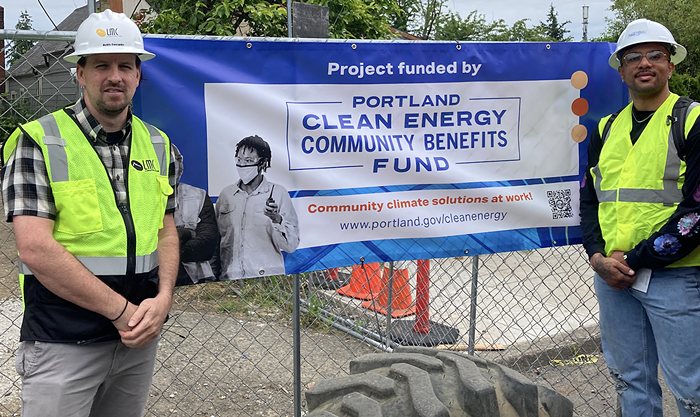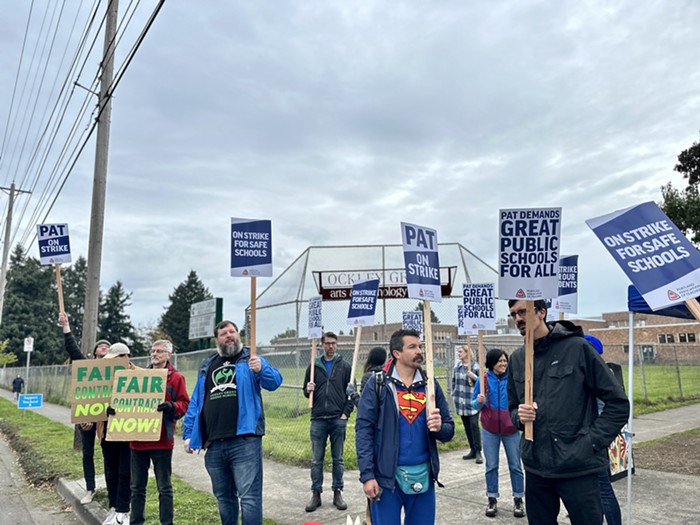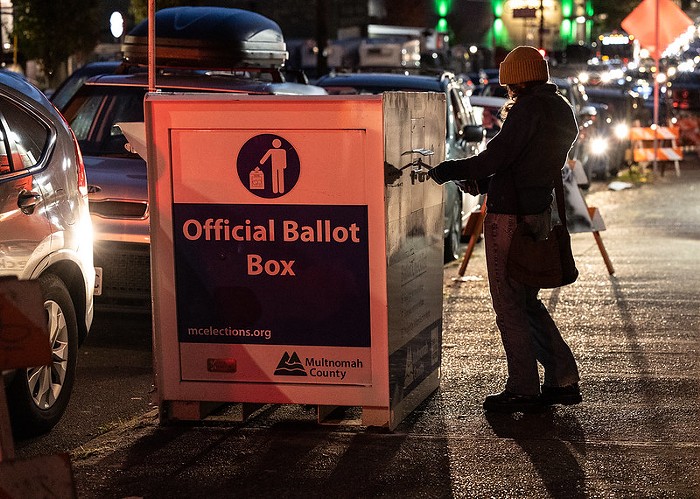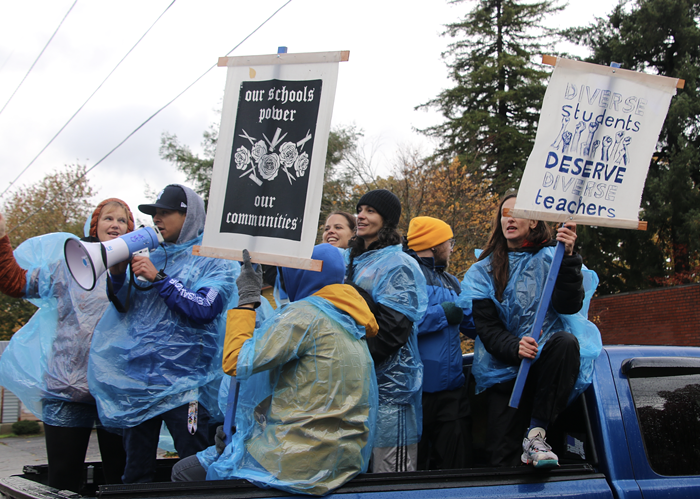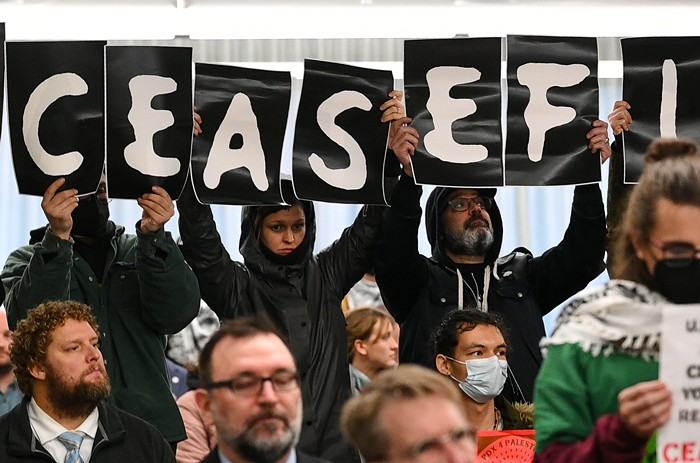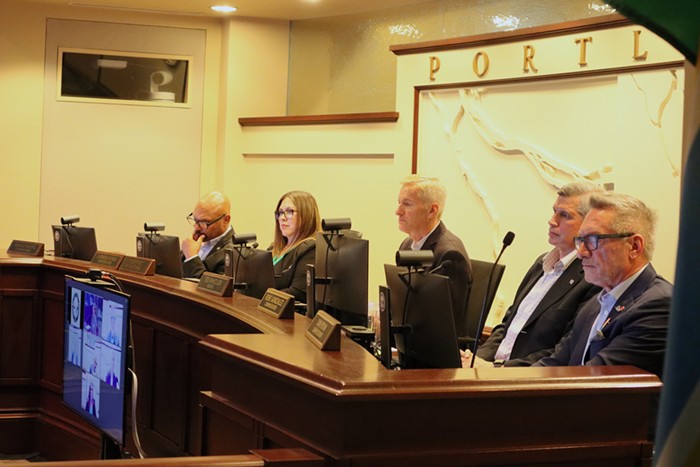FROM THE BURNSIDE SKATEPARK, the Yard tower is hard to miss.
The "Death Star," as Burnside's regulars call the 21-story apartment building, is conspicuous even at a distance—being one of the only high-rises across the Willamette River from downtown. But up close, it hovers over the city's most storied skatepark, generating a chorus of industrial noises night and day, and blocking out most natural light. The gritty skatepark and major residential development are next-door neighbors, separated only by temporary fencing and a few feet of mud and rocks.
And as the apartment project prepares to take on residents this summer—and needed upgrades to the Burnside Bridge loom further out—it's easy to wonder: What happens to Burnside, a landmark founded when its now-hip locale was less than desirable?
The people who built the skatepark are wondering the same thing. But there's hope among them that it will thrive.
"Burnside's not going anywhere," says Sage Bolyard, a skater who's been a part of the park for almost all of its 25-year existence. "We're just worried about having to continually fight for it."
Mark Scott, co-founder and unofficial head of Burnside, credits Yard's development team as being easy to work with. They've treated park representatives like stakeholders, he says, and will spend $30,000 on lights to illuminate the plunging concrete bowls and ramps their building perches over.
That good feeling isn't universal. There's grumbling at the park about construction workers taking all the parking. There's been outcry on social media over the use of skaters in Yard promotional materials, which some feel is disingenuous, and the displacement of skating features by the construction.
Scott and the rest of Burnside's founders have known for years something like this was coming.
Portland's Central Eastside, the hard-edged industrial neighborhood they helped tame in the early 1990s, has since become something else entirely. Now littered with construction sites, it's one of the fastest-changing neighborhoods in a city struggling to manage unprecedented growth.
Burnside Skatepark has been slower to change. From sunup to sundown, the park is still the scene of world-class, high-flying, highly technical skateboarding. Rangy and unshaven youths from around the world still slap their decks on the smooth concrete when someone finishes an especially sick line.
At night, the park takes on a more depressing air. After all, it is located under a bridge in Portland. In recent years—as housing prices and drug use have both soared—Burnside's increasingly become a magnet for problematic activity.
"There's a drug problem in Portland, and I'm not sure what anybody can do about it," Scott says. "It's fucked. I've got hours of stories."
It's gotten bad enough he's had to kick out one longtime regular—a guy who helped him trowel the original features of the park—after complaints. Scott says the park has a front-row seat to watch two major Portland stories play out: gentrification and homelessness.
"Yeah, there are lots of characters down there. But what do we do, fence it off? Get a key and lock it up at night? Get more police? I don't know." In light of these issues, Scott says, "the new development might just be a positive thing."
Francis Rodman, 23, is among the homeless near the park—but for him it's by choice. About a year ago, he and some fellow skaters loaded into a van in "the other Portland," in Maine, to travel, park-to-park, out West. They've been living off Burnside in that van now for almost four months.
"I knew it was going to be gnarly," he says. "But then you come here, and it's like this whole new world. This is the best place in the world to skate."
Skateboarding is much different today than for the generation that built Burnside. When the park was slowly being constructed in 1989-1990, sanctioned places to skate barely existed. Indoor, fee-based facilities started popping up in California in the 1970s, but proved costly to insure and difficult to run. Howard Weiner, operator of Cal Skate in Old Town, tried his hand with one in Portland—Rip City Skate—which closed in the late 1980s, leaving a big hole.
The story of Burnside, often retold, is one of a group of kids looking for a place to skate, finding none, and building their own. Scott's landlord objected to a plan he and his roommate, Chuck Willis, had to build ramps in their backyard, so they eyed a piece of land no one cared about—one covered from the rain 24/7.
It's difficult to imagine today how rough that area was back then, Willis says. Needles. Barrel fires. Johns waiting in parked cars.
"You could go scare 'em to death with your skateboard while they weren't expecting it," says Willis, 47. "We started coming down there with brooms, so we wouldn't land on any of the glass. We sort of had to make a presence there."

- Will Corwin
Not concerned with legalities, they built wall ramps against the bridge abutments. The passion project took flight after park leaders made a deal with a concrete manufacturer during construction of an Interstate 84 on-ramp. Soon nearby business owners realized that a skatepark could positively affect their neighborhood, and lobbied on Burnside's behalf before city officials.
In the years since, the park has become a skateboarding Mecca, featured as a level in the first Tony Hawk's Pro Skater video game. Local skater Paul Fuijta wrote an article in Transworld skate magazine in 1997 defending Portland from critics, and describing the great skating at Burnside and around the city.
"People still tell me they moved here because of that article," Fujita says.
Given its DIY backstory—and the tendency of beloved Portland institutions to give way in the face of a tsunami of new development—it's fair to ask how secure the park is.
"There's no doubt that that building has gotten the attention of the skate community," says Tom Miller, former director of the Portland Bureau of Transportation and a longtime Portland skatepark advocate. "Things have largely stayed the same down there for many years, and obviously, the Central Eastside has changed. But there hasn't been this much potential to impact the park."
Burnside was never supposed to last in the first place, Miller says, but has persisted because skaters established key relationships with property owners and the Central Eastside Industrial Council business group, and those relationships have endured.
It's not just new development posing a threat. Last year, the county began a $3 million study to seismically upgrade the 90-year-old Burnside Bridge. The final plan will likely cost around $500 million and take 12 years. But as the park is literally built inside the bridge, on public right-of-way, any plan would have an effect.
For now, Burnside representatives take comfort in knowing that money is tight and the county's checklist is long. But construction will likely continue as a way of life at the bridgehead, even after Yard's anticipated opening in July. Earlier this month, Scott, Bolyard, and others met at the park with county representatives to go over smaller upcoming bridgework expected to conclude in 2017.
And park boosters are thinking of taking a more novel tack for shielding the park from changes: securing its spot as a historic landmark. That's something Miller has floated to the leaders of Burnside. State and local preservationists tell the Mercury that Burnside would certainly qualify for designation, but it would take extremely rare circumstances for it to occur before the park is 50 years old—the traditional benchmark.
It's not a surefire strategy. Many skateparks older than Burnside have been demolished, including one in Tampa that was listed on the National Register of Historic Places. But the fact the Florida park was listed in the first place—combined with fact that the Burnside Bridge itself is on the register—could be helpful in getting Portland's most Portlandy skatepark added to the list, says Val C. Ballestrem, education manager of the Architectural Heritage Center in Portland.
"This would certainly be a unique preservation story," he says. "It's an interesting idea... it certainly makes sense."
Whatever happens going forward, Burnside's legacy is secure. A number of world-renowned park builders got their hands wet at the park. Bolyard is a part of Grindline Skateparks, one of the country's most prestigious builders. Scott's Dreamland Skateparks is building a project now in Haifa, Israel. Scott tells the Mercury he'd like to start phasing out his involvement with Burnside, and for new blood to get involved with the nonprofit.
"When I look at the history, I think I'm looking at the future," Miller says. "Relationships make the world go 'round, and if you continue to do what you've done historically, you should be fine, right?"
